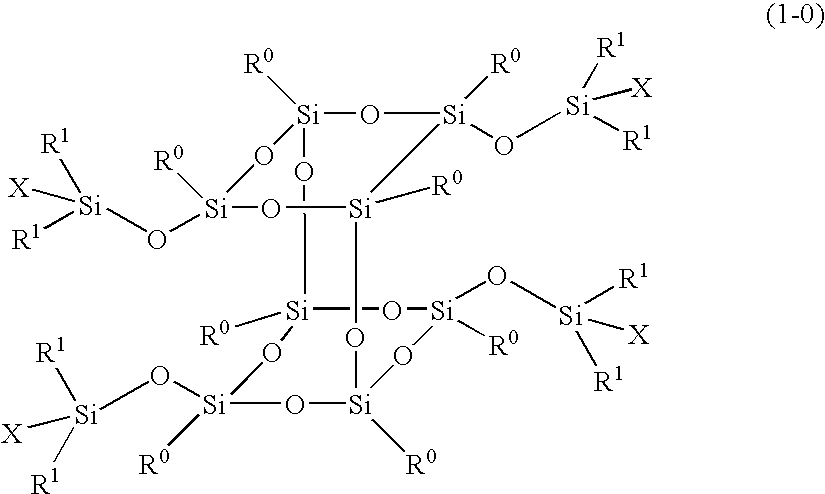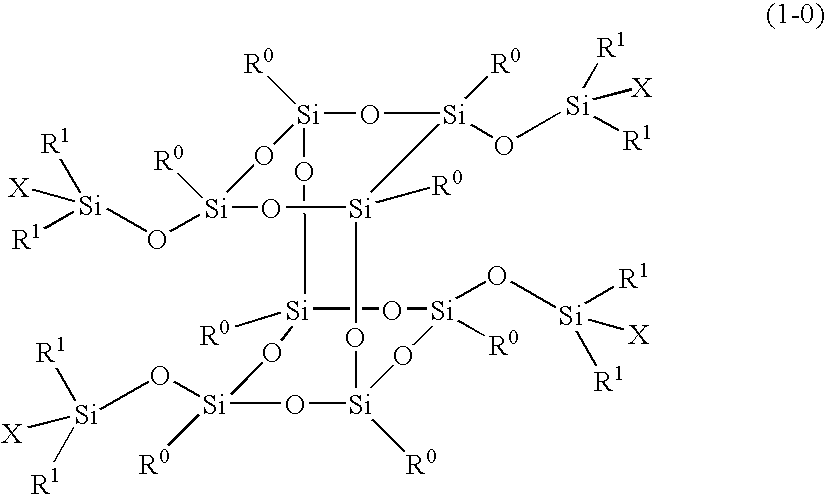Polymer obtained by using silsesquioxane derivative
a technology of silsesquioxane and derivatives, applied in the field of polymer obtained by using silsesquioxane derivatives, can solve problems such as inapplicability of definitions, and achieve the effect of easy extraction
- Summary
- Abstract
- Description
- Claims
- Application Information
AI Technical Summary
Benefits of technology
Problems solved by technology
Method used
Image
Examples
example 1
[0147] Compound (7) (0.5 g), Compound (8) (1.8 g) and Compound (9) (0.55 g) were dissolved in toluene (15 mL). The solution was heated to 90° C., to which a Karstedt catalyst (1 μL) was then added, followed by stirring at the same temperature for 2 hours. The polymer in the reaction liquid obtained was measured for molecular weight with GPC, and thus it was found that Mn=2,700 and Mw=5,100. The reaction liquid was dropped on a glass plate, and toluene was evaporated therefrom to obtain a smooth and transparent film adhered on the surface of the glass. It was heated to 300° C. for 1 hour and measured for film hardness by the pencil hardness test, and it was H or more. The film thus heated was immersed in toluene at room temperature for 1 hour while the film was adhered to the glass, and then it was visually observed. As a result, no change was found in the film, and thus the resulting polymer film was good in solvent resistance.
example 2
[0148] The reaction liquid obtained in Example 1 was applied by the spin coating method on a glass substrate having been subjected to chromium plating, and then heated to 80° C. for 3 minutes. It was further heated to 220° C. for 30 minutes to obtain a transparent film with good adhesiveness having a thickness of 3.5 μm. The film was measured for refractive index with an Abbe refractometer, and thus it was 1.567. The film was measured for relative dielectric constant with LCR Meter 4263B, produced by Hewlett-Packard Corp., and thus it was 2.8 (1 KHz).
example 3
[0149] The reaction liquid obtained in Example 1 was applied by the spin coating method on a glass substrate having been subjected to chromium plating, and then heated to 80° C. for 3 minutes. It was further heated to 220° C. for 30 minutes to obtain a transparent film with good adhesiveness having a thickness of 1.5 μm. The film had a light transmittance of 90% or more in a wavelength range of from 380 to 720 nm.
PUM
| Property | Measurement | Unit |
|---|---|---|
| carbon number | aaaaa | aaaaa |
| carbon number | aaaaa | aaaaa |
| carbon number | aaaaa | aaaaa |
Abstract
Description
Claims
Application Information
 Login to View More
Login to View More - R&D
- Intellectual Property
- Life Sciences
- Materials
- Tech Scout
- Unparalleled Data Quality
- Higher Quality Content
- 60% Fewer Hallucinations
Browse by: Latest US Patents, China's latest patents, Technical Efficacy Thesaurus, Application Domain, Technology Topic, Popular Technical Reports.
© 2025 PatSnap. All rights reserved.Legal|Privacy policy|Modern Slavery Act Transparency Statement|Sitemap|About US| Contact US: help@patsnap.com



